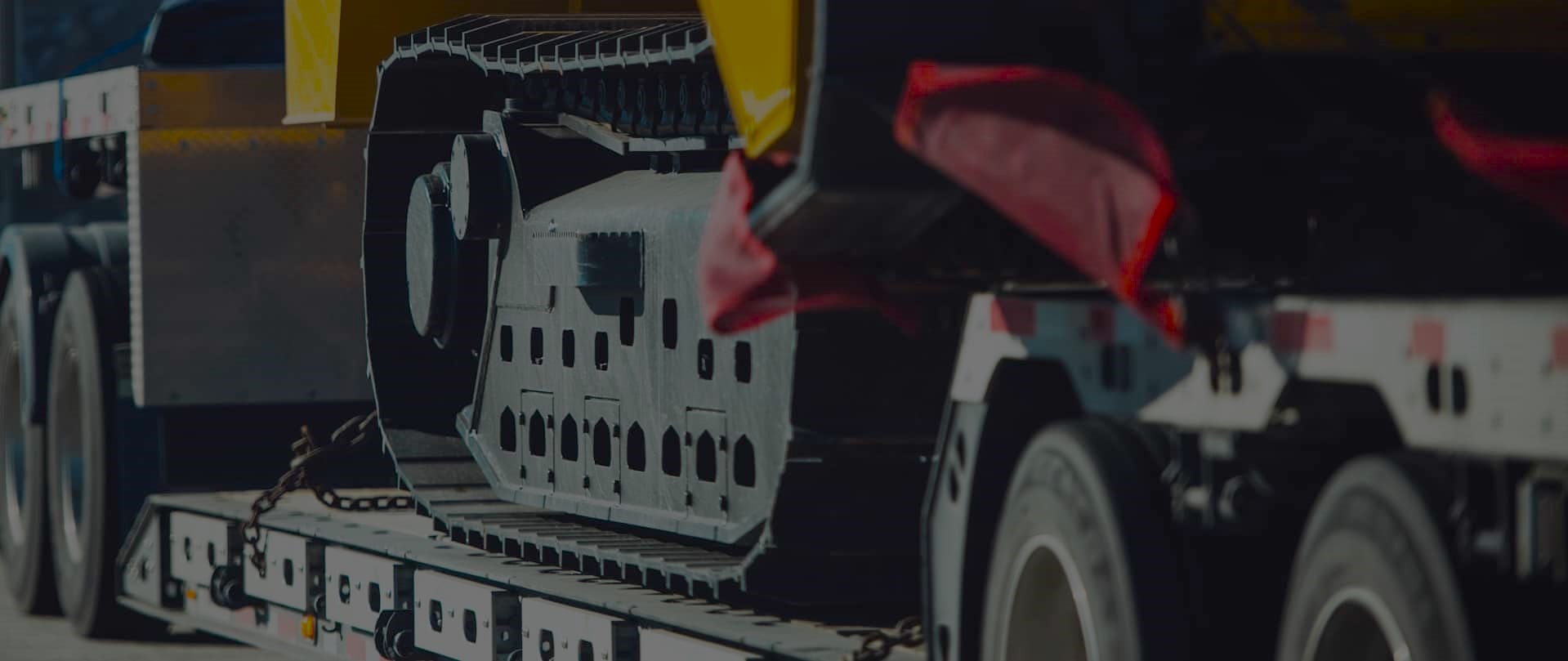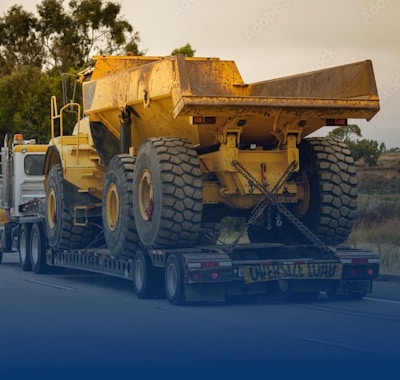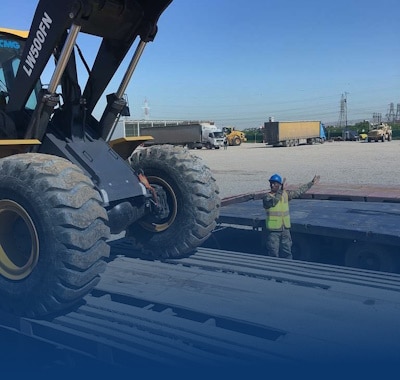Why Gulf Coast Humidity Complicates Heavy Haul Securement
Freedom Heavy Haul can offer expedited Pickup and Delivery for any size shipment anywhere in the USA. Contact us today for No Hassle, No Pressure Pricing.
Persistent coastal moisture changed how teams prepared loads and inspected gear. Drivers had to watch friction, corrosion, and visibility because these three factors directly affected stability when moving large equipment across long routes.
Moisture-laden air and frequent condensation increased strap stretch, chain rust, and slick trailer decks. That raised real operational challenges for crews who needed quick, clear checks before departure and on the road.
Inspections often failed to catch early metal fatigue or hidden wear. That meant strict maintenance routines and drying steps became standard practice to keep loads steady in variable weather.
This Best Practices Guide would cover material choice, seasonal adjustments, permitting and tech-assisted monitoring. It also emphasized simple, on-the-ground tactics like deck treatments and drying protocols.
Trusted partners mattered. Testimonials from Bilbo Baggins, Tim Allen, John Armstrong, and Elizabeth Martin praised Freedom Heavy Haul for quick callbacks and personal attention. Those traits helped coordinate complex schedules and reduce delays in storm-prone conditions.
Setting the stage: Gulf Coast weather conditions and heavy haul realities
The region’s cycle of hot days and storm fronts forces teams to adapt routes and timelines constantly. Operations here must balance routine checks with quick responses to changing skies.
Coastal Louisiana and nearby areas see frequent tropical storms, strong winds, and surges. Low elevations and wetlands keep decks and gear near-constant damp. That creates ongoing condensation cycles that affect straps, chains, and trailer surfaces.
- Surface dampness: Heat plus tropical moisture and frequent rain drive slick decks and reduced traction.
- Route exposure: Weather patterns focus moisture along low-lying corridors and wetland-adjacent roads, increasing hazards.
- Logistics impact: Planners must map flood-prone segments, identify covered staging, and prepare alternate routes quickly.
“Quick reroutes and clear dispatch-driver communication save permits and reduce delay risks.”
Permit windows shrink when extreme weather causes slippage. So teams add buffer time, stage under cover when possible, and align checks with likely seasonal risks to keep heavy hauling moving safely.
Why Gulf Coast humidity complicates heavy haul securement
When decks and straps pick up moisture, physics works against crews trying to keep equipment firmly in place. Friction drops as tiny water films act like a lubricant on both wood and steel surfaces. That change makes it easier for a load to shift during acceleration, braking, or cornering.
Moisture, corrosion, and reduced friction: the physics behind slipping loads
Lower friction coefficients on wet decks reduce grip for ramps, chocks, and pads. Synthetic straps can absorb water and relax after initial tension. Chains and ratchets start surface rust that can cut rated capacity over time.
Humidity’s impact on tie-downs, chains, binders, and trailer decks
Untreated wood may swell and host algae, both of which reduce traction. Smooth steel decks develop condensation and become slick fast. Use a mix of galvanized and coated hardware with regular lubrication and covers to slow corrosion.
Visibility, condensation, and driver decision-making at load sites
Fogging of mirrors and lenses at dawn or after short rains impairs sightlines at critical moments. Drivers should expect brief “flash condensation” when stepping from cool cabs into warm, wet air and pause before final checks.
- Best practice: mandate early re-inspections when conditions stay damp.
- Check: retorque straps after initial settling and inspect chains for light rust.
- Plan: stage under cover when possible and allow time for drying.
| Issue | Effect | Action |
|---|---|---|
| Wet deck surface | Lower friction; slips possible | Apply anti-slip mats; clean algae |
| Synthetic straps wet | Stretch after tensioning | Retorque and re-check en route |
| Corrosion on chains | Reduced load rating | Use galvanized parts; lubricate |
Material choices that resist humidity: equipment and trailer best practices
A smart material plan reduces corrosion and keeps loads steady in salt-laden air. Start with hardware and finish with deck treatments to cut maintenance and avoid mid-route fixes.
Coatings and hardware: choose galvanized chains and polymer-coated binders over bare steel. Zinc and polymer finishes slow rust and help maintain rated working loads in damp conditions.
- Synthetic vs steel: webbing is lighter and resists corrosion but can absorb water and stretch; steel holds shape but needs coatings and regular treatment.
- Components to specify: sealed bearings, stainless fasteners, and weather-resistant ratchet mechanisms to lower downtime and extend equipment life.
Deck choices and anti-slip options: rough-sawn hardwood with anti-slip grit, rubberized mats, and serrated steel grating raise friction on damp mornings. Use removable, oil-resistant mats under contact points of heavy equipment for added grip.
| Issue | Material | Action |
|---|---|---|
| Chain corrosion | Galvanized or polymer-coated | Choose coated parts; schedule inspections |
| Slippery deck | Hardwood, rubber mat, serrated steel | Install anti-slip surfaces; seal end grain |
| Condensation cycles | Fasteners and bearings | Store under cover; monitor temperatures and dew points |
Document choices and intervals in operations manuals so fleets use the same parts and follow consistent replacement schedules. That record-keeping improves performance across trailers and helps crews manage wear from shifting daily temperatures.
Seasonal dynamics: integrating humidity with year-round heavy haul challenges
Cold snaps and fleeting freezes can turn routine loads into high-risk moves overnight. Winter brings snow, freezing rain, and occasional icy roads that form on bridges and shaded corridors. On coastal-adjacent routes, moisture plus low temperatures can create black ice fast.
Winter and spring
Spring thaw weakens pavements and triggers seasonal weight limits. States may cut legal axle weights by large percentages during thaw windows, so route planning and axle distribution matter.
Moisture-laden gear is common in these months. Use sheltered staging, drying protocols, and retorque binders after initial tensioning to avoid frozen straps and lost tension.
Summer and autumn
Summer heat raises tire pressures and blowout risk, and softens some asphalt. Pair tire checks with cooling system maintenance and planned driver breaks.
Autumn brings leaf-slick surfaces and early frosts, plus shorter daylight that compresses operating windows. Increase lighting checks and tighten coordination to keep schedules realistic.
- Seasonal checklist: tire chains or seasonal tires, antifreeze and pre-heat, updated route plans, and weather monitoring.
- Operational tip: build seasonal variance into delivery promises and permits to allow buffer time for changing road conditions.
| Season | Primary risk | Action |
|---|---|---|
| Winter | Black ice, icy roads | Chains, slowed speeds, monitor temperatures |
| Spring | Thaw-weakened roads | Adjust loads, route to strong pavement |
| Summer/Autumn | Tire wear, leaf-slick, reduced daylight | Tire checks, lighting, staged breaks |
Route planning, permits, and compliance when roads meet moisture
Route selection must match seasonal weight rules to prevent costly detours and fines. Start by checking spring thaw limits and Bridge Gross Weight Formula compliance for every state on the lane. In Michigan, for example, legal axle weights can fall by up to 35% between March and May.
Document readiness matters: keep permit copies, axle charts, and pre-approved routes accessible. Train crews on seasonal rules and store DOT contact points in a central repository for quick calls when road conditions change.
Spring load limits, bridge formula compliance, and alternate routes
Align axle spacing and gross weights to the federal bridge formula before applying for permits. Build an alternate routes playbook with verified clearances and infrastructure ratings to bypass flooded segments or restricted corridors.
Buffer time, permitted loads, and dynamic reroutes during weather events
Add extra time to schedules for permitted loads during volatile weather events. Coordinate dynamic reroutes with permitting authorities and escorts so operations stay compliant if a corridor becomes impassable.
- Pre-trip: standardized route reviews that note historic problem spots in wet periods.
- On-road: real-time updates from logistics to drivers to change routes before delays grow.
- Admin: a centralized file of permit windows, state rules, and DOT phone lists.
| Challenge | Impact | Best action |
|---|---|---|
| Spring thaw weight reductions | Lower legal axle limits; fines if exceeded | Verify bridge formula compliance; adjust loads |
| Flooded or restricted corridors | Forced detours; permit timing risk | Use validated alternate routes; notify escort/authority |
| Permit expiration during delays | Potential violations, schedule slips | Build buffer time; keep permit copies and axle charts ready |
Inspection protocols to counter humidity-induced failures
A short, repeatable checklist helps crews spot weakened links, swollen straps, and slick contact points before departure. Inspecting with moisture in mind keeps teams safe and saves time when conditions change.
Pre-trip, en route, and post-trip checks for chains, straps, and anchor points
Pre-trip: examine chains and binders for surface rust, lubricate ratchets, confirm straps show no fraying, and ensure anchor points are free of water and debris.
Have drivers verify lights and visibility aids, then sign a brief log. That practice supports consistent operations and faster handoffs.
En route and post-trip: re-check after 50–100 miles and after storms. Re-tension straps, re-verify torque on binders, and note any changes in contact surfaces to avoid mid-route resets.
Corrosion audits, torque verification, and moisture mitigation at tie-downs
Schedule teardown audits quarterly or after sustained wet stretches. Inspect coatings, galvanization wear, and any deformation that reduces rated capacity.
- Use calibrated torque tools and record readings centrally for repeatability.
- Fit protective sleeves and edge guards; add water-shedding covers at tie-downs.
- When possible, dry contact points before final tensioning to lock in rated tension.
Deck cleanliness: removing algae, leaves, and condensate for traction
Keep decks clear of algae, leaves, and standing water to restore grip under heavy equipment. Add anti-slip media or mats at known slick spots and clean after rain bursts.
| Issue | Effect | Action |
|---|---|---|
| Algae and leaves | Slippery surface | Scrape, sweep, apply anti-slip mat |
| Condensate | Reduced friction | Wipe dry, delay final tensioning |
| Worn coating | Faster corrosion | Schedule recoating and audits |
Disciplined inspections cut avoidable delays and reduce the chance of on-road load shifts. Consistent checks make the road safer and keep projects on schedule despite seasonal challenges.
Driver training and on-road tactics for humid, slick environments
Drivers must learn to read slick micro-climates on a route and change inputs before a small slide becomes a major incident. Training should pair classroom instruction with supervised road time so lessons stick.
Speed, stopping distance, and controlled braking
Adjust speed for wet decks and damp surfaces. Increase following distances and use progressive brake application to avoid skids.
Teach drivers to brake earlier and in short, steady pulses. That reduces lateral forces on tie points and helps keep loads stable.
Visibility management and safe staging
Keep windows and mirrors defogged and auxiliary lights clean and aimed. Good visibility shortens reaction time on foggy mornings and after storms.
Choose staging areas with solid lighting for final checks and re-torques before long runs.
- Include winter modules: teach ice recognition for bridges and shaded spots, and when tire chains are legal and useful.
- Use communication: radio and app check-ins let operations update drivers about sudden closures or hazards.
- After-action: ride-alongs and field reports convert incidents into training improvements and better route notes.
| Focus | Action | Benefit |
|---|---|---|
| Speed control | Reduce speed, extend distance | Lower stopping distances risk |
| Visibility | Defog, clean lights, stage well | Faster recognition of hazards |
| Communication | Real-time check-ins | Quick reroutes and alerts |
Technology and logistics: real-time weather, sensors, and communication
Telematics and layered weather feeds put clear, minute-by-minute data in the hands of dispatchers and drivers. Integrate GPS with high-resolution forecast apps to spot precipitation cells, lightning, and micro-climate fog before they affect routes.
Transportation management systems unify permits, planned lanes, and customer updates so logistics teams keep compliance while reacting to weather events. That single source of truth reduces phone tags and speeds decision-making.
Load sensors and smart alerts
Fit strain gauges and tension monitors to chains and straps. These devices send instant alerts when stretch or vibration indicates loosening on moist decks. Push notifications reach both drivers and dispatch to trigger early retorques or staging.
- Integrate telematics with weather apps to preempt route changes and staging moves.
- Use geofenced alerts around known low spots and causeways to force safer reroutes.
- Log adjustments to build data-driven expertise for similar routes and seasons.
| Tool | Main benefit | Action |
|---|---|---|
| Telematics + forecast | Anticipate cells | Reroute before impact |
| Load sensors | Detect loosening | Auto-alert driver/dispatch |
| TMS | Permit & updates | Single source for logistics |
Test systems during clear days and keep two-way communications active with customers. That preserves trust when schedules shift and keeps operations safer and more efficient.
Operational playbook: proactive planning and maintenance that pay off
A clear operational playbook keeps crews ready when weather shifts and permit windows shrink. Use checklists, daily weather scans, and buffer windows to protect schedules and reduce unplanned work.
Scheduling with extra time lets teams stage under cover and follow drying protocols for straps, binders, and decks before final torque. That step cuts the chance of mid-route adjustments and costly delays.
Scheduling, staging, and drying
Establish an SOP that adds extra time during storm-prone periods. Require covered staging where possible and a drying step before departure.
Tire chains, seasonal tires, and brake cooling
Specify when to fit tire chains or seasonal tires for rare ice or steep grades, and set clear removal rules to protect pavements.
For hot, steep corridors, use brake cooling practices: controlled descents, spaced braking, and system checks to avoid fade when temperatures climb.
- Preventive maintenance: front-load inspections before peak seasons and check coolant, brakes, and electrical systems.
- On-board kit: moisture-wicking rags, anti-fog spray, dehumidifier packets, and spare coated hardware.
- Pre-trip brief: include temperature and dew point checks so crews plan re-checks around condensation windows.
| Focus | Action | Benefit |
|---|---|---|
| Scheduling | Add buffer time; daily weather scans | Fewer permit slips and fewer delays |
| Staging & drying | Cover staging; dry straps before torque | Stable tie-downs; less mid-route work |
| Seasonal gear | Use tire chains per criteria; service brakes | Better traction; reduced brake fade |
| Supplies & checks | On-board dehumidifiers; weekly reviews | Faster repairs; continuous improvement |
Putting it together: proven solutions to keep heavy equipment moving
Bringing material choices, inspections, training, and tech together makes operations more resilient in shifting conditions. Use galvanized and coated hardware, anti-slip deck treatments, and load sensors to spot tension loss early.
Plan proactively: stage under cover, build buffer time, and keep alternate routes ready. Respect spring load limits and the bridge formula to stay compliant when roads change.
Trust experienced partners for fast callbacks, clear customer updates, and practical expertise that solves on-road challenges. Document wins on each corridor and keep training current so every heavy haul and heavy equipment move stays safe, predictable, and customer-focused.







